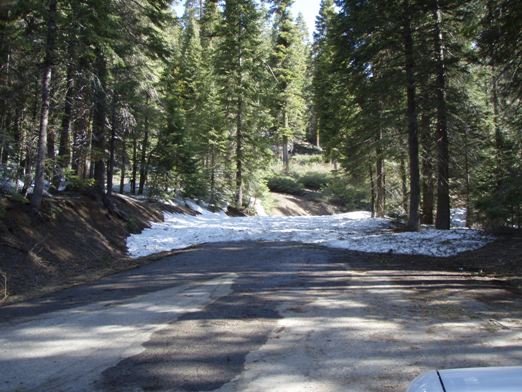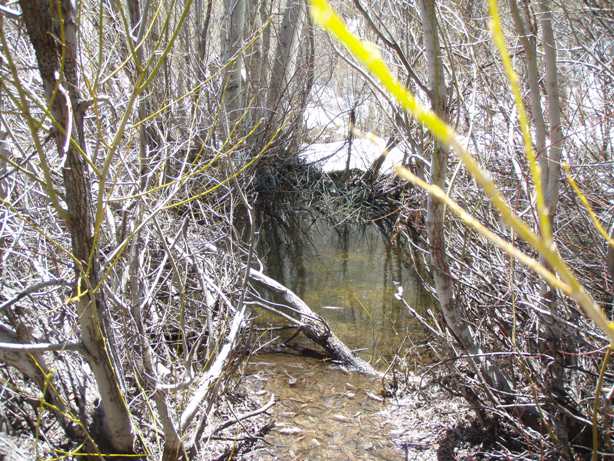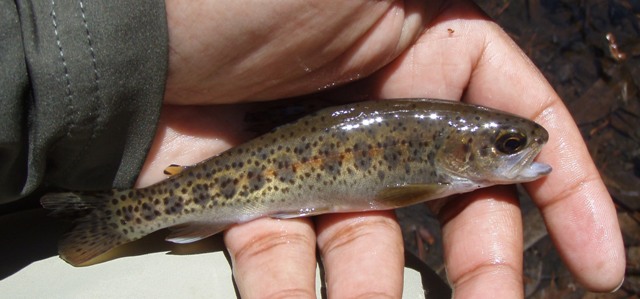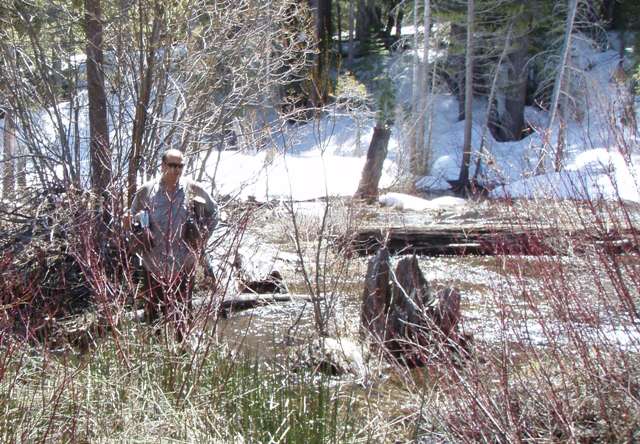|
|
|
|
|
|
|
April 27, 2008 - Sequoia National Forest Plan C Creek:
Time:
11:30am - 2:30pm (This is the second day of a two day fishing weekend. The first trip was skunked in Yosemite.)
Sunday I had planned to fish a Little
Kern Golden (LKG) Trout stream with Casey from the VFS Southwest board. He lives
in southern California and I in the north. I would be coming from the
central valley and we figured if we both left our respective areas at 5am,
we'd be right behind each other on the single road leading to our
destination.
I made good time driving south on highway 99 and made it into Porterville about 20 min. behind Casey. We each drove separate cars up a narrow road into the Sequoia National Forest. During the drive along the windy road to our chosen stream, several signs caught my eye, all with the same theme- "road closed".
We ascended the mountain, hoping the road closure was after the turn off to the LK Golden stream. The further we drove, the better our chances looked. It looked like our luck would hold out, the main road was clear but we turned the corner to the access road to find 2 to 3 feet of snow blocking our route. The stream was only 6 miles away, not terribly far for a hike late in the season but this early, without the proper equipment and safety measures, such a trek would be unwise.
I probably should have expected this. In Yosemite the previous day, the trail to Butterball Creek was covered with much more snow than is usual. This was at ~5,000 feet and we were now at ~6,000 feet. The southern Sierra was covered with snow, several feet in some cases. It was a rookie move. I probably should have anticipated this. We've had good snow fall and the days have not been overly warm but it simply never entered my mind that the roads would be closed and that there would be snow on the ground. I'd been to the stream before, knew where I was going and so I didn't bring my usual topo map. I didn't have a plan B.
Normally that wouldn't be much of an issue as I would simply turn around and go home. That wasn't an option. I'd asked someone else to travel the 3 or 4 hours to meet me here so we scoured our DeLorme maps for a plan B creek. We found a creek not to far down a trail and endeavored to find it. The trail of course was covered in snow and anyone that has tried to walk on snow in felt covered boots knows its no fun.
Fortunately, the trail began in a meadow with a stream flowing through it. It looked as if it might hold water year around and even if it didn't, there's always the possibility fish move up into the small trickle in the winter. We figured it was worth a few casts; at worst we spend a half hour on fishless water and you can find some of the best streams by speculating. We plied the water for 30 min to an hour and then started looking for plan C creek. Casey remembered a near by stream that he'd fished before. I was familiar with the stream from my research for the Heritage Trout Challenge. The stream qualifies as native territory for the Kern River Rainbow and is so close to a native LKG stream that I will not name it here, despite the campsite, bait fishers, fact that DFG plants it with non-native trout and beer cans that littered the place.
We drove to plan C creek and found it was about a mile past the road closure. When we pulled up, several fisherman were climbing the snow mound that prevented cars from going any further. They carried a stringer of 5 or so 10 to 12 inch fish- an encouraging, yet pathetic sight. Casey and I made small talk and then headed to the stream ourselves.
The stream was brushy, not so choked as Butterball in some places but enough to make things challenging. The melting snow created enough run off and small pockets to simulate a stream in some places. Once we found the main stem, we went to work. I caught and landed my first fish in a small brush choked pocket that reminded me of Los Huertos Creek in New Mexico. The hole in the brush was just large enough for me to kneel in.
Kneeling outside of the brush, I sent a bow and arrow cast into the pool. It drifted a few seconds and was aggressively taken by a small fish or so I thought. The fish had been foul hooked in the belly. I took a picture and released it. I quickly found myself fighting another 3 or 4 inch fish. This fish was fair hooked and was the last I would land.
Not long after, I broke the tip of my rod in one of those "do as I say, not as I do" situations that I, as a rod maker, would warn my friends and customers about. I knew the tip of this rod would break the day I finished it. My rod making forms didn't go down to the proper dimensions so I cheated and used sand paper to finish the tip. Unfortunately I picked up the wrong grit and the finished tip was extremely thin. Not only that but there was a very distinct and visible drop in taper between 4 and 5 inches along the rod tip. It was simply a matter time. I knew this and when I stuck my rod under a snow bank were my fly had been trapped I could feel the rod snap and actually hear the sound travel up the rod. I really like this rod, not so much because of the action but because if the cosmetics and have had the strips for a second tip sitting on my bench for the last 6 months. Looks like it's time to start that second tip.
Once I broke the tip I could not land a single fish. It would be easy to blame the rod but I simply wasn't fishing smartly. At one point I hooked into my largest fish of the day. Fighting my way through the brush I suck my head out and found a great looking run down stream. It was narrow and deep. On my side there was over hanging brush on the other a steep snow bank. My best approach would be from the snow bank so I crossed the stream, climbed up the snow bank (no easy feat in felt shoes) and rolled myself into position.
I made several casts, working the run systematically. With the river at 40 degrees, I probably should have made 6 casts to each area of the run instead of two. At these temps you really have to hit the fish over the head with the fly. On my second cast above a small bush on the snow side, I hooked a 10 inch fish. Instead of keeping the rod tip low and pulling the fish out from under the brush, I kept the rod tip high, causing the fish to tangle in the branches and come off. When I hooked a similar fish or the same fish again in the same spot, I hadn't learned from my mistake and gave it a nice Long Distance Release. LDR's aside, of which there were many, it was great fun.
Casey picked up the largest fish of our day, about 6 inches I think he said, from what was arguably the most perfect hole of the stream. It was an absolutely beautiful run with a long protected glide and some pocket water at the bottom of a small riffle. At one point, I almost waded down into it, such was the denseness of the brush. I left him fishing the middle section of the run and went around the corner and over a hill. I figured I was at least two holes upstream from him. I fished the area and at one point I could see a small pocket below me. I drifted my fly down a bit then decided to reposition myself and wade down a bit further to get a better angle. The fish couldn't see me due a bush above the hole and as I waded closer, I was surprised to see that it was actually the very top of Casey's run.
We finished fishing around 2:30pm and headed home. I was glad to be leaving early because the jet lag from my week in Hong Kong hadn't hit me until about 4:30pm the day before. I was betting on a similar experience today and confident that I would have plenty of time to get off the mountain safely. The road down was narrow, with a river gorge on the uphill side and very few places to pull over. "No parking" signs lined the road on both sides. I was making fairly good time on the way down. The road was all curves and I was concentrating on the corners, breaking before the turns and sweeping through. About half way down I started to feel a bit tired. No problem I thought. I've always been a pretty good judge of how sleepy I am and always pull over. I wasn't feeling sleepy, simply weary and figured I would simply continue down the mountain to one of the two or three recreation areas at the bottom. This would take an additional 15 or 30 mins. No problem- the day before I hadn't needed to pull over until 4:30pm and then I was sleepy. It was only 3:00pm and I wasn't feeling sleepy.
It happened suddenly as I was coming down a longish straightaway with a sharp, unprotected right hand corner. One second I was preparing to break for the corner and the next second I was out on my feet. For a split second, I was asleep with my eyes open, I could see the corner and approaching cliff, in fact I was staring straight at the drop off and it felt like dreaming, a second later something in my brain clicked. I remember thinking to myself in my dream, "I'm supposed to be fishing". I realized I shouldn't be sleeping and what my eyes were taking was real, even if my body was asleep. Suddenly my body jolted and I took a deep breath as if I had been startled from a deep sleep. I applied the breaks and rounded the corner without any drama. Adrenaline shot through my body and I imagined for a minute what it would have felt like to make that realization 5 seconds later and wake up seeing a fast approaching field of rocks and river. "What a stupid way to die", I imagined myself thinking as I careened over the edge. I never thought that could happen, my eyes didn't feel heavy, I didn't close them. I was in and out of dream state in seconds, probably less.
Interestingly, when I was in Hong Kong I'd watched a program on the Discovery Channel about the mind and sleep. According to the program, if the body doesn't get enough rest, the mind will simply shut it down, suddenly, with little care for what it's currently doing. Only the survival senses remain active. I guess that's what happened to me. I didn't feel like I wasn't getting enough rest but obviously my body felt otherwise.
Previous "Other" National Forest Chronicle Next "Other" National Forest Chronicle
|




